Control Active Choice of Variant Subsystem During Simulation or Execution of Generated Code
You can change the active variant of a Variant
Subsystem block during simulation or execution of the generated code by using a
Parameter Writer
block to model the variant change. To enable run-time activation of variants, in the Block
Parameters dialog box of the Variant Subsystem block, set Variant
activation time to runtime. To set the block parameter
programmatically, enter this command in the MATLAB® Command
Window:
set_param("Variant Subsystem",VariantActivationTime='runtime')
Variant Subsystem is the name or handle of
the subsystem.Place a Parameter Writer block inside a conditionally executed subsystem or
in an event function. Use the Parameter Writer block to write to a variable
that you use in a condition expression for variant control. The variant control variable can
be a Simulink.VariantControl object with the
ActivationTime property set to 'runtime'. In
this case, when a Variant Subsystem block has Variant
activation time set to Inherit from
Simulink.VariantControl, the block inherits a variant activation time of
runtime from the Simulink.VariantControl
object.
Set the Destination parameter of the Parameter Writer block based on the location of your variant control variable:
Block parameter— Control variable is a mask parameter in a subsystem.Model workspace variable— Control variable is located in the model workspace.Base workspace variable— Control variable is located in the base workspace or a data dictionary.
For example, you can create a mask parameter V in a
subsystem and use it in a variant expression for a variant control. The Parameter
Writer block writes the value of V.
You can also modify the variant control variable from external code by using the C API interface. To enable C API code generation for control variables, select the model configuration parameter Generate C API for: parameters (Simulink Coder). For more information on using the C API interface, see Get Started with C API (Simulink Coder).
Modeling Guidelines
When configuring your model to use run-time variants, consider these modeling guidelines:
Place the Variant Subsystem block with run-time activation time outside of the Initialize Function, Reset Function, or Reinitialize Function blocks. Avoid using a Variant Subsystem block with
runtimeactivation within these functions.Use the equality operator in variant control expressions during run-time activation to prevent the occurrence of multiple active variants during simulation. This is necessary because using condition expressions with inequality operators, such as
V ~= 1andV ~= 2, may result in a scenario where the value ofVis 3, activating multiple variants simultaneously.Use startup activation time if you do not require changing the variant at each step but require selecting the active variant just before the run.
For more information, see Configure Instance-Specific Values for Block Parameters in a Referenced Model.
A model exchange FMU block can be used as a run-time variant. Co-simulation FMU blocks are not supported for run-time activation.
For run-time activation, the Validate Parameter parameter of the Parameter Writer block must be selected.
Control Run-Time Variants Using Base Workspace Variable
This example shows how to control the active variant of a run-time Variant Subsystem block by using a variable in the base workspace.
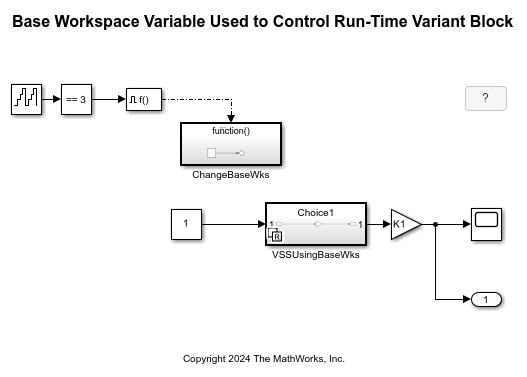
In this model, the active variant of run-time Variant Subsystem block RuntimeVariantBaseWorkspace/VSSUsingBaseWks is controlled by using the condition expressions V_base == 1 and V_base == 2. The variable V_base is defined in the base workspace. The Parameter Writer block PW1, contained in the function-call subsystem RuntimeVariantBaseWorkspace/ChangeBaseWks, controls V_base.
During simulation, the Parameter Writer block changes the value of V_base to switch the active variant. You can see this switch by observing the change in output value at time step 3.
Control Run-Time Variants Using Mask Workspace Variable
This example shows how to control the active variant of a run-time Variant Subsystem block by using a variable in the mask workspace.
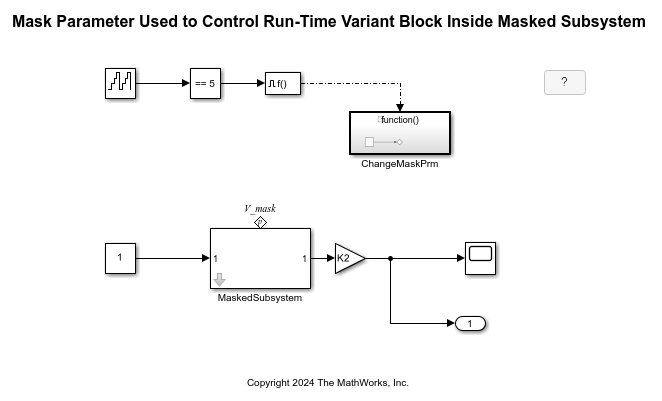
In this model, the active variant of run-time Variant Subsystem block RuntimeVariantMaskWorkspace/VSSUsingMaskParam is controlled by using the condition expressions V_mask == 1 and V_mask == 2. Parameter V_mask is defined in the RuntimeVariantMaskWorkspace/MaskedSubsystem subsystem mask. The Parameter Writer block PW2, contained in the function-call subsystem RuntimeVariantMaskWorkspace/ChangeMaskPrm, controls this mask parameter value.
During simulation, the Parameter Writer block changes the value of V_mask to switch the active variant. You can see this switch by observing the change in output value at time step 5.
Control Run-Time Variants Using Model Argument
This example shows how to control the active variant of a run-time Variant Subsystem block by using a model argument.
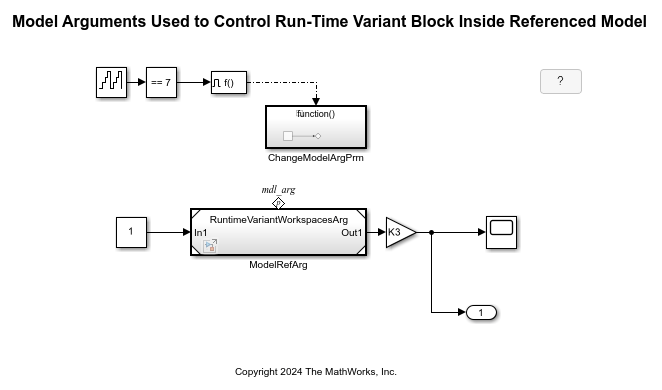
In this model, the active variant of run-time Variant Subsystem block RuntimeVariantModelArgument/VSSUsingModelWksAndArg is controlled by using the condition expressions mdl_arg == 1 and mdl_arg == 2. Parameter mdl_arg is defined in the model workspace for subsystem RuntimeVariantWorkspacesArg.

The model block RuntimeVariantWorkspacesArg/ModelRefArg uses mdl_arg as an instance parameter to control the run-time variant block in the referenced model. You can have multiple instances of the same model with different values. This model uses only one instance of the model slexRuntimeVariantWorkspacesArg/ModelRefArg. The Parameter Writer block PW3, contained in the function-call subsystem RuntimeVariantModelArgument/ChangeModelArgPrm, controls this argument value.
During simulation, the Parameter Writer block changes the value of mdl_arg to switch the active variant. You can see this switch by observing the change in output value at time step 7.
When you use model arguments, clear the Argument check box on the Instance parameters tab of the Model Reference Block Properties dialog box.
Control Run-Time Variants Using System Mask
This example shows how to control the active variant of a run-time Variant Subsystem block by using a variable in a system mask.

In this model, the active variant of run-time Variant Subsystem block RuntimeVariantSystemMask/VSSUsingModelWksAndSysMask is controlled by using the condition expressions mdl_sysmask_val == 1 and mdl_sysmask_val == 2. Parameter mdl_sysmask_val is defined in the model workspace for subsystem RuntimeVariantWorkspacesSysmask.
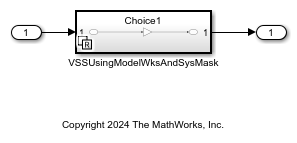
In this model, the parameter mdl_sysmask_val has a system mask so that it behaves like any other masked block. The model block ModelSysMask uses this parameter to control the run-time variant block in the bottom model. The Parameter Writer block PW4, contained in the conditional subsystem ChangeSysMaskPrm, controls this system mask parameter value.
During simulation, the Parameter Writer block changes the value of mdl_sysmask_val to switch the active variant. You can see this switch by observing the change in output value at time step 9.
Switch Active Variants at Run Time Using a Parameter Writer Block Inside a Conditional Subsystem
This example shows how to change the traffic signal lights for a traffic control system by using run-time variants.
Explore the Harness Model
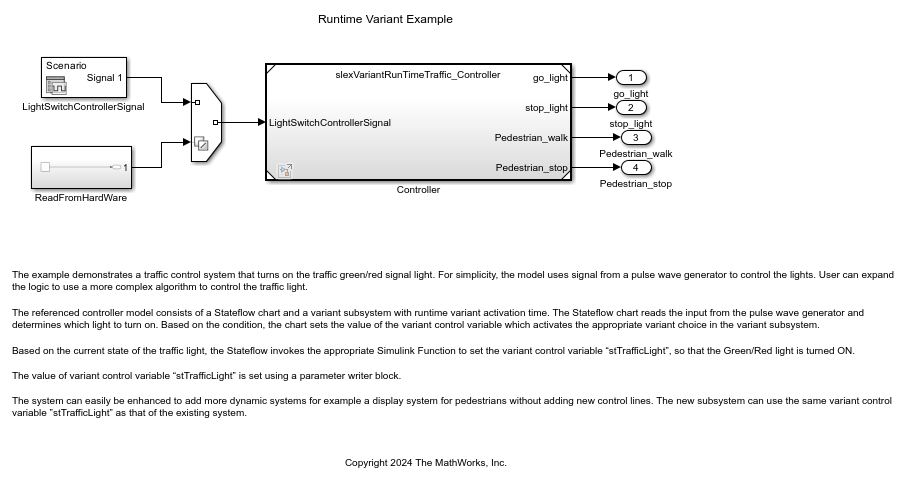
This harness model uses a Variant Source block with the Variant control mode parameter set to sim codegen switching to automatically switch the input signals between simulation and code generation.
For simulation, signals from a pulse wave generator controls the signal. For code generation, you can replace the ReadFromHardware subsystem with production logic that provides the signal inputs.
Explore the Controller Model
Open the traffic control system model slexVariantRunTimeTraffic_Controller.
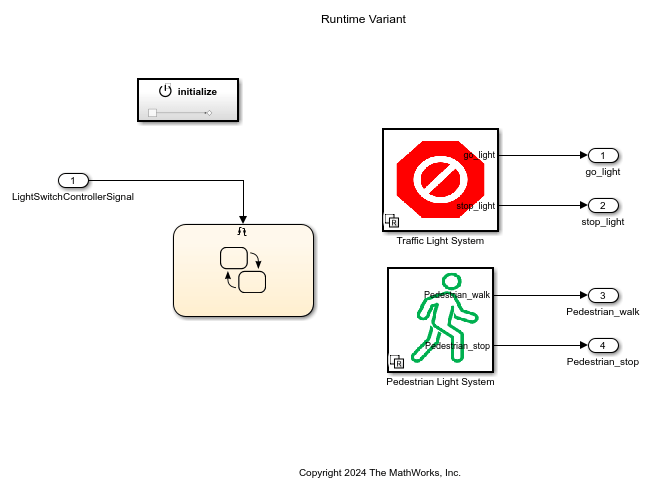
In this model, the Initialize Function block is used to initialize the variant control at the beginning of simulation or execution of the generated code.
The controller model contains a Stateflow® chart and a variant subsystem configured for run-time activation.
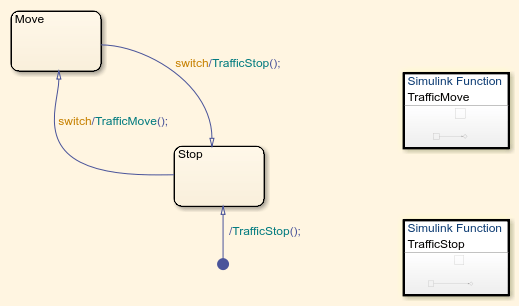
The Stateflow chart determines which light is turned on by using the input signal as a trigger. Depending on the current state of the signal, Stateflow invokes the corresponding Simulink Function block, TrafficMove or TrafficStop, to set the variant control variable stTrafficLight by using a Parameter Writer block. The variant control variable stTrafficLight activates the corresponding variant choice, go or stop, within the Variant Subsystem block.
The contents of the TrafficMove and TrafficStop Simulink Function blocks are as shown below:
TrafficeMove
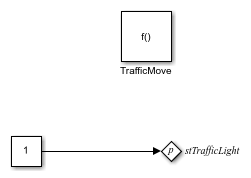
TrafficeStop

Mask icons are promoted automatically to the run-time variant subsystem to show the change in active variant during simulation.
An additional variant subsystem in the controller model uses the same variant control variable stTrafficLight (with opposite logic) to control a pedestrian crossing light.
Switch Active Variants at Run Time Using a Parameter Writer Block Inside an Event Function
This example shows how to use startup and run-time variant activation times to calculate the torque demand for a truck capable of operating in both two-wheel and four-wheel drive modes.
During startup, the system assesses whether the truck is equipped for a two-wheel drive system or switchable four-wheel drive system. If the truck has a switchable four-wheel drive system, the run-time variant selects between the two-wheel and four-wheel modes during the run, taking into account the external conditions and driver overrides. A startup variant determines whether to use the two-wheel drive system or the switchable four-wheel drive system.
Explore the Harness Model
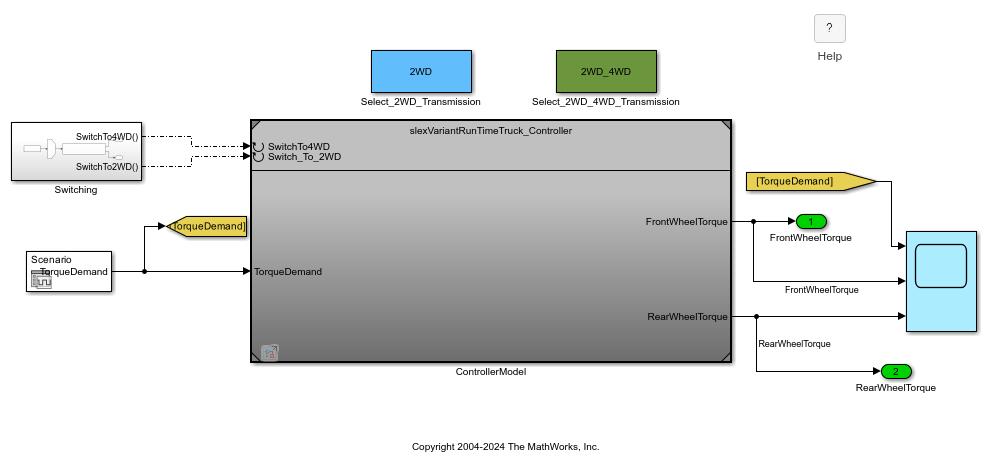
In the top model, at the top of the canvas, you can select whether to run the model as a two-wheel drive or a switchable four-wheel drive truck by double-clicking the 2WD or 2WD_4WD block. The block callbacks set the value of the variant control variable that corresponds with the selected truck design. The Reset Function block in the referenced model triggers the run-time variant switching in a switchable four-wheel drive truck.
The top model can only be used in simulation mode, but the referenced model can be used for simulation as well as code generation.
Explore the Controller Model
Open the referenced controller model slexVariantRunTimeTruck_Controller.
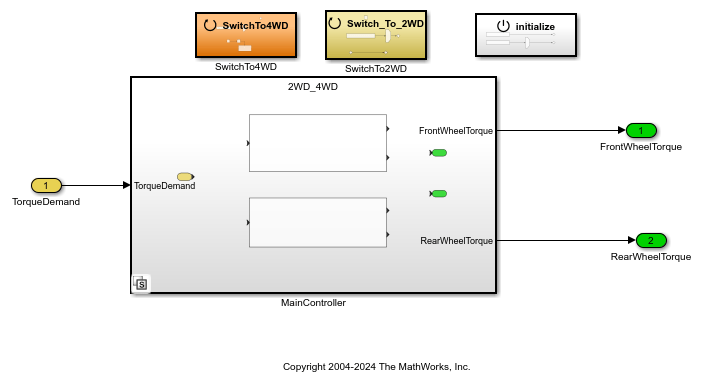
The controller model uses startup variant activation time to select the truck drive type.

If the truck is a switchable four-wheel drive truck, the model uses run-time variant activation time to switch between drive types based on external inputs.
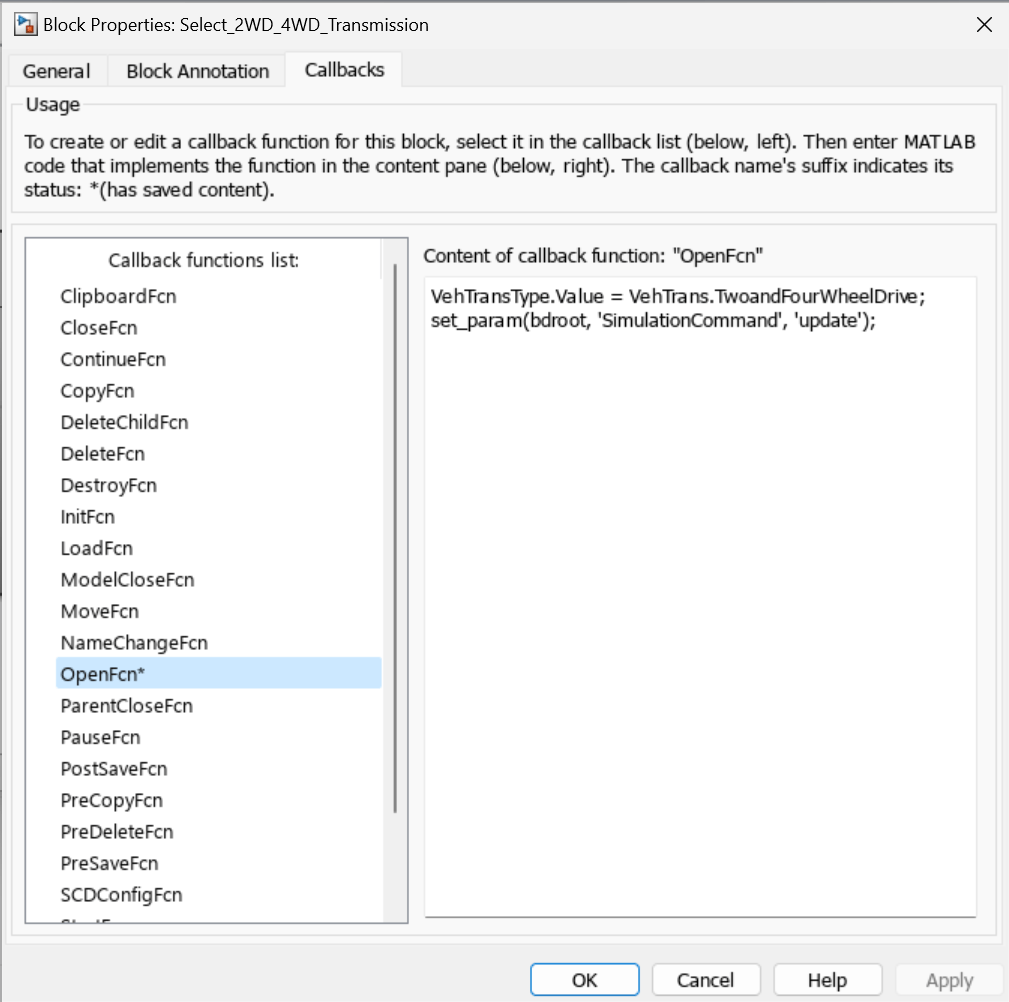
During run-time switching, State Reader and State Writer blocks transfer states between drive modes. State transfer ensures a smooth transition of output during run-time variant switching.
The Initialize Function block sets the truck type based on the argument received from the top model. If the truck type is set to a switchable four-wheel drive, the system is initialized to four-wheel drive mode.
Note that within the Initialize Function block, there is a Variant Source block with the condition expression VehTransType==VehTrans.TwoandFourWheelDrive. The VehTransType value is assigned by the first Parameter Writer block. Without block priority, Simulink sorts blocks based on their names.
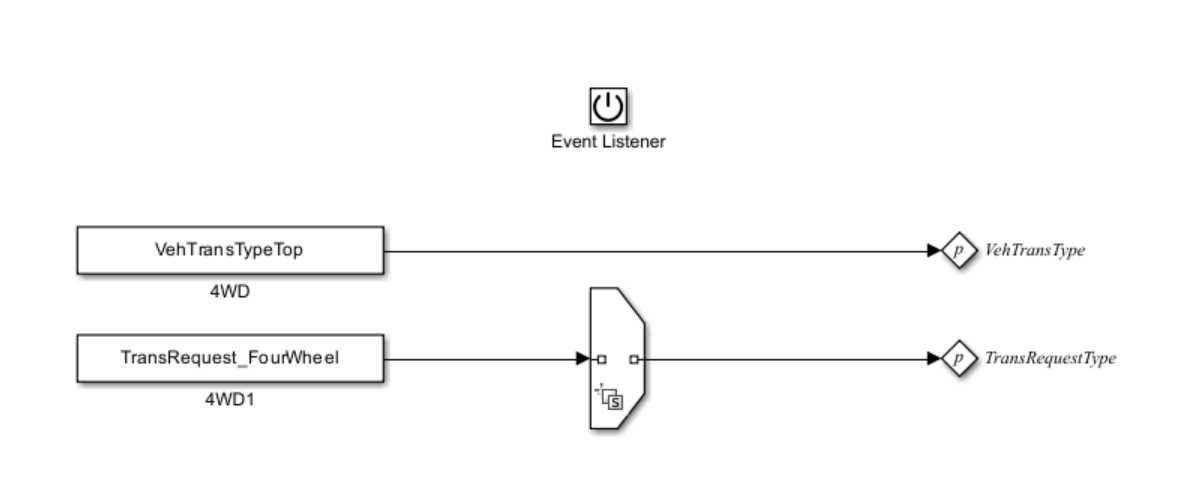
Analysis of Simulation Output
When the truck is set to the two-wheel drive configuration at startup, the torque for the rear wheels remains at zero throughout the simulation, and the torque demand is met entirely by the front wheels.
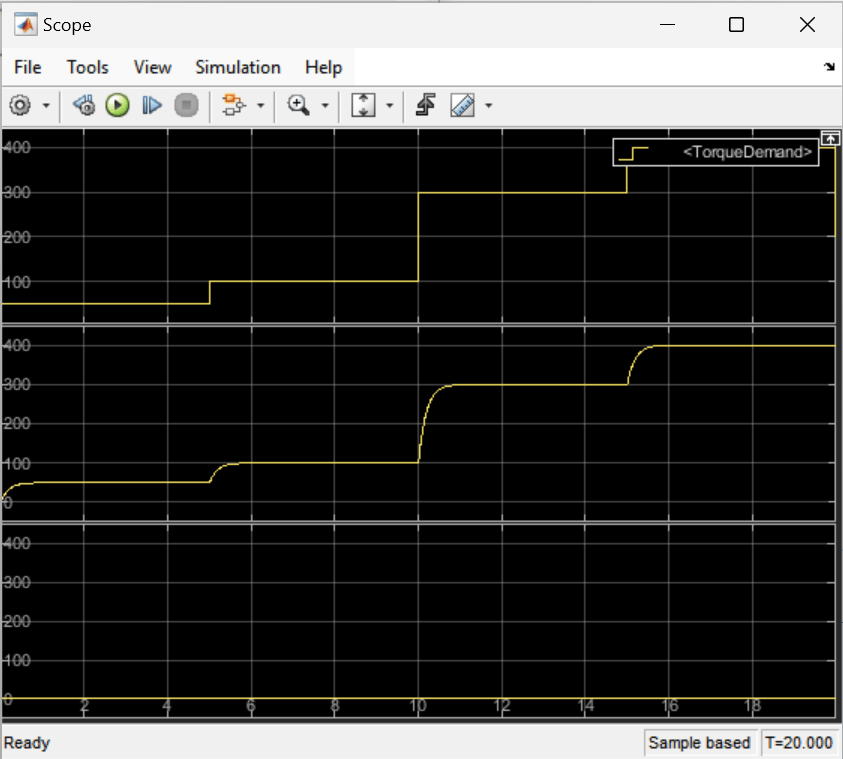
When the truck is set to the switchable four-wheel drive configuration at startup, the rear wheel torque is calculated only when the four-wheel drive is active.
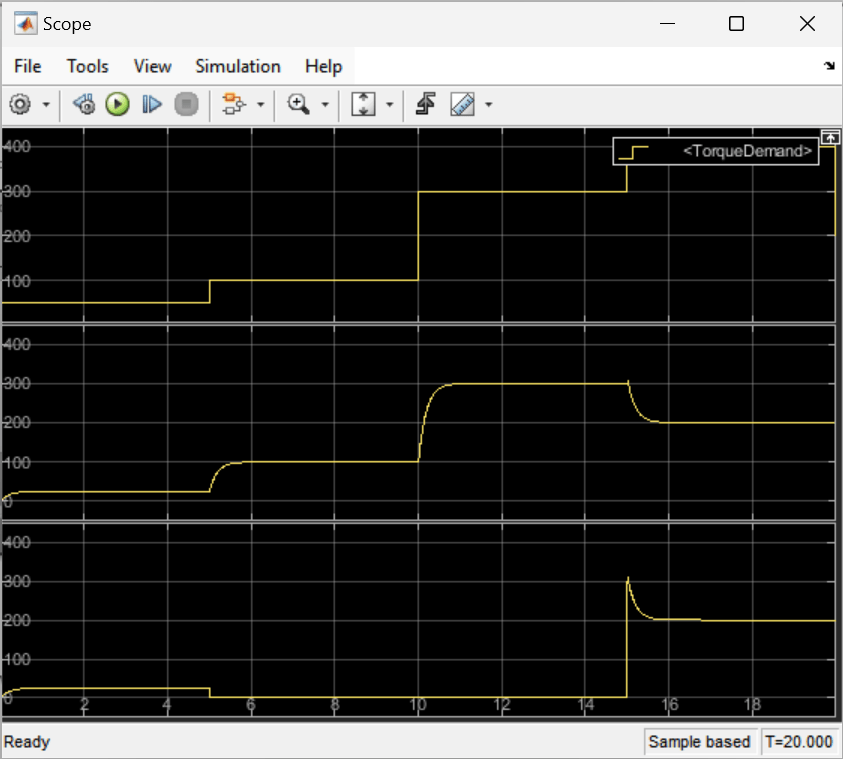
Analysis of the Generated Code
Generate code for the controller model.
All states within the system are unconditionally initialized within the slexVariantRunTimeTruck_Controller_initialize() function. This function helps the initialization of states with initial condition values when explicit state initialization is not done during run-time variant switching. In this example, the run-time variant control variable TransRequestType is explicitly initialized within the Initialize Function block using a Parameter Writer block.
The state handoff happens inside the functions slexVariantRunTimeTruck_Controller_SwitchTo4WD() and slexVariantRunTimeTruck_Controller_Switch_To_2WD(). The top model invokes these functions to switch the run-time variant.
void slexVariantRunTimeTruck_Controller_SwitchTo4WD(void)
{
if (slexVariantRunTimeTruck_C_InstP.VehTransType == TwoandFourWheelDrive) {
slexVariantRunTimeTruck_Contr_P.TransRequestType =
slexVariantRunTimeTruck_Contr_P.TransRequest_FourWheel;
}
Code Generation with Run-time Variants
To use run-time variants with code generation, set the model configuration parameter
Default parameter behavior to Tunable. The
code generator generates conditional code as part of an if-elseif-else
statement similar to this:
void mParamWrWithOutIRTAndbaseW_codegen_step(void)
{
mParamWrWithOutIRTAndbaseW_co_B.Compare =
(mParamWrWithOutIRTAndbaseW_c_DW.Output_DSTATE ==
mParamWrWithOutIRTAndbaseW__co_P.CompareToConstant_const);
if (mParamWrWithOutIRTAndbaseW_co_B.Compare) {
V = mParamWrWithOutIRTAndbaseW_co_P.Constant1_Value_c;
}
if (V == 1) {
mParamWrWithOutIRTAndbaseW_co_Y.Out1 =
mParamWrWithOutIRTAndbaseW_co_P.Gain_Gain *
mParamWrWithOutIRTAndbaseW_co_P.Contant1_Value;
} else if (V == 2) {
mParamWrWithOutIRTAndbaseW_co_Y.Out1 =
mParamWrWithOutIRTAndbaseW_co_P.Gain_Gain_a *
mParamWrWithOutIRTAndbaseW_co_P.Contant1_Value;
}
mParamWrWithOutIRTAndbaseW_c_DW.Output_DSTATE +=
mParamWrWithOutIRTAndbaseW_co_P.FixPtConstant_Value;
if (mParamWrWithOutIRTAndbaseW_c_DW.Output_DSTATE >
mParamWrWithOutIRTAndbaseW_co_P.WrapToZero_Threshold) {
mParamWrWithOutIRTAndbaseW_c_DW.Output_DSTATE =
mParamWrWithOutIRTAndbaseW_co_P.Constant_Value;
}
}
void mParamWrWithOutIRTAndbaseW_codegen_initialize(void)
{
mParamWrWithOutIRTAndbaseW_c_DW.Output_DSTATE =
mParamWrWithOutIRTAndbaseW_co_P.Output_InitialCondition;
}
void mParamWrWithOutIRTAndbaseW_codegen_terminate(void)
{
}
Use System Mask and Model Arguments to Control Variant Blocks at Run Time
You can control variant blocks at run time using model arguments. Select a parameter in
the model workspace and tune it using the top model reference block. For example, you can
use a Simulink.VariantControl object as a variant control variable. By
configuring the object as a model argument, you can pass different values for the variable
to each instance of a Model block. Similarly, when you use a
Simulink.VariantControl object as a variant control variable in a
Simulink.VariantVariable object, you can configure the variant control
variable as a model argument and pass different values to each instance of a
Model block to have different values for the
Simulink.VariantVariable object in the referenced model.
When you configure a Simulink.VariantControl object as a model argument:
The object must be in the model workspace.
The value of the object must be a
Simulink.Parameterobject or a numeric type.ActivationTimeproperty must be set tostartuporruntime.
To configure a Simulink.VariantControl object as a model argument, in
the Model Explorer, select Argument for the object. For more
information about model arguments, see Configure Instance-Specific Values for Block Parameters in a Referenced Model.
To use a system mask, click the Create System Mask button from the referenced model.
Handling Blocks with States
When the variant choice blocks switch from active to inactive or from inactive to active, you must model the state hand-off or reset explicitly. To achieve the state hand-off or reset, you must use the State Reader or State Writer blocks.
States with initial conditions are unconditionally initialized by the model start or initialize function. You must explicitly reset or reinitialize the states by using the Reset Function block and Reinitialize Function block.
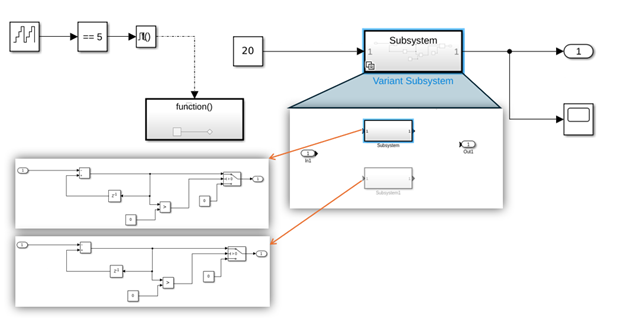
For example, the model illustrates the switching of the active variant from one to the other through the Parameter Writer block from a function-call subsystem. However, a state hand-off or reset is missing when switching occurs.
Comparison of Different Variant Activation Times
The table compares the different variant activation times based on conditional code, variant switching, handling of states, and fast restart support.
update diagram or update diagram analyze all
choices | code compile | startup | runtime | |
|---|---|---|---|---|
| Generated conditional code | Inactive conditional code is not available. | Conditional code is present inside preprocessor macros. The inactive choice code is eliminated when generated code is compiled. | Conditional code is generated as part of an if-elseif-else
statement. The variant control variable value cannot be modified during
execution. | Conditional code is generated as part of an if-elseif-else
statement. The variant control variable value can be modified during
execution. |
| Variant switching during simulation or code execution | Not supported. | Not supported. | Supported at startup (before simulation start at t = 0). | Supported. The active variants are switched by changing the variant control variable using the Parameter Writer block. |
| Explicit setting of held or reset option for states | Not supported. States are reset for inactive blocks. | Not supported. States are reset for inactive blocks | States cannot be changed during simulation. In the generated code, if you attempt to change the variant, states are in held state. | States are held by default. States can be reset explicitly through state writer blocks. Blocks with states can be read by using the State Reader block and can be transferred to other choice by using the State Writer block. |
| Executable size | Smaller size. Code is not generated for the inactive variant. | Smaller size. The inactive variant code is removed during compilation. | Comparatively larger size. Both active and inactive variant code is available for startup switching. | Comparatively larger size. Both active and inactive variant code is available for run-time switching. |
| Fast restart support | Not supported. | Not supported. | Supported. | Supported. |
Limitations
Limitations for run-time variants include:
Run-time variants are supported only for Variant Subsystem blocks and not inline variant blocks such as Variant Source or Variant Sink.
Simulink® Real-Time™ workflows with Model blocks containing IRT ports are not supported.
HDL Coder™ does not support run-time variants.
Blocks with continuous time signals are not compatible with run-time variants.
Multiple variant control variables are not supported for run-time variants.
See Also
Variant Subsystem | Parameter Writer